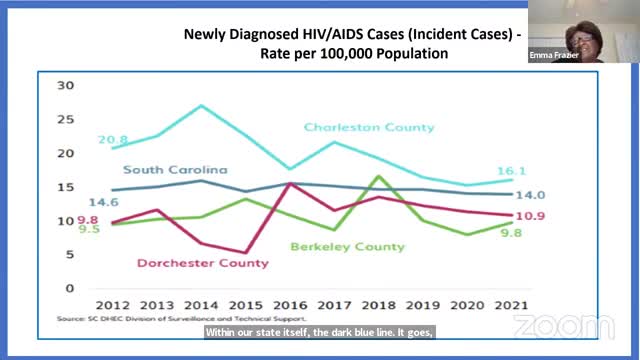Data reveals alarming HIV AIDS trends in Charleston County
June 06, 2024 | Charleston City, Charleston County, South Carolina

This article was created by AI summarizing key points discussed. AI makes mistakes, so for full details and context, please refer to the video of the full meeting. Please report any errors so we can fix them. Report an error »

In a recent government meeting, officials presented alarming statistics regarding the prevalence and management of HIV/AIDS in the Tri-County area of South Carolina, highlighting significant disparities among different demographics and counties.
The data revealed that Charleston County consistently reported the highest rate of new HIV cases from 2012 to 2021, surpassing both Berkeley and Dorchester counties, as well as the overall state rate. In 2021, the prevalence of HIV/AIDS was notably higher among non-Hispanic Black individuals, with Charleston County again leading in rates for Hispanic or Latino populations.
The meeting also addressed the HIV/AIDS continuum of care, which tracks patient management over time. Key metrics included the percentage of individuals receiving care, those retained in continuous care, and the rates of viral suppression. Berkeley County showed the highest percentage of individuals who received any care, while Dorchester County led in retention of continuous care. Notably, Berkeley County also had the highest rate of viral suppression, indicating effective management of the disease among those diagnosed.
Officials emphasized the importance of antiretroviral therapy (ART) in improving health outcomes for individuals living with HIV, underscoring the concept of \"undetectable equals untransmissible\" (U=U). This principle highlights that individuals with an undetectable viral load can lead longer, healthier lives without transmitting the virus to others.
The discussions underscored the urgent need for targeted interventions and resources to address the disparities in HIV/AIDS care and outcomes across the Tri-County area, particularly for marginalized communities.
The data revealed that Charleston County consistently reported the highest rate of new HIV cases from 2012 to 2021, surpassing both Berkeley and Dorchester counties, as well as the overall state rate. In 2021, the prevalence of HIV/AIDS was notably higher among non-Hispanic Black individuals, with Charleston County again leading in rates for Hispanic or Latino populations.
The meeting also addressed the HIV/AIDS continuum of care, which tracks patient management over time. Key metrics included the percentage of individuals receiving care, those retained in continuous care, and the rates of viral suppression. Berkeley County showed the highest percentage of individuals who received any care, while Dorchester County led in retention of continuous care. Notably, Berkeley County also had the highest rate of viral suppression, indicating effective management of the disease among those diagnosed.
Officials emphasized the importance of antiretroviral therapy (ART) in improving health outcomes for individuals living with HIV, underscoring the concept of \"undetectable equals untransmissible\" (U=U). This principle highlights that individuals with an undetectable viral load can lead longer, healthier lives without transmitting the virus to others.
The discussions underscored the urgent need for targeted interventions and resources to address the disparities in HIV/AIDS care and outcomes across the Tri-County area, particularly for marginalized communities.
View full meeting
This article is based on a recent meeting—watch the full video and explore the complete transcript for deeper insights into the discussion.
View full meeting